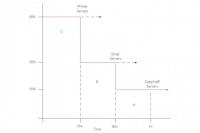 Add My Company
Add My Company
Sign In

Load shedding is the process whereby, a process where the load on a UPS is reduced by sequentially powering down specific hardware when the UPS is running on battery power.
This deliberate shutdown on electric power in parts, will prevent a failure of the entire system when the demand tensions the capability of the UPS system. This reduces the load on the UPS system and increases the runtime for the remaining loads.
The diagram displays how the network should be prioritised into A,B and C order in which ‘A’ type loads must be kept running for the longest time and ‘C’ type loads the shortest time.
Priority shutdown
The priority shutdown can be achieved in three ways:
Programme output sockets available on some UPS systems
Intelligent power distribution units
UPS system monitoring and control shutdown software – with each server configured to run for different time periods before shut down.
Load shedding is most common practise of managing potential UPS downtime where there are multiple servers or server clusters to protect.
For more information on Load shedding – the best way to manage your UPS downtime talk to Adept Power Solutions Ltd
Enquire Now
List your company on FindTheNeedle.

